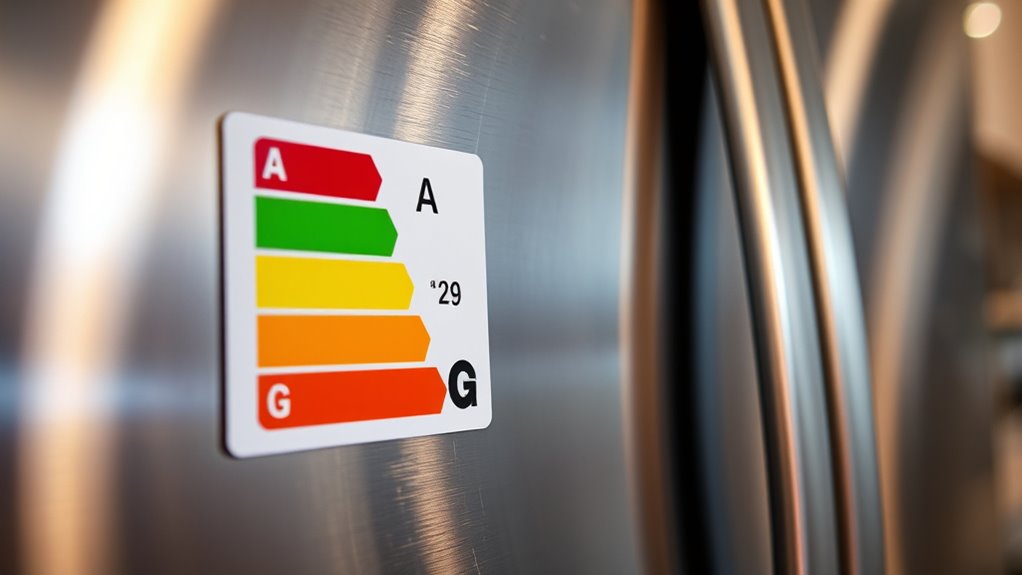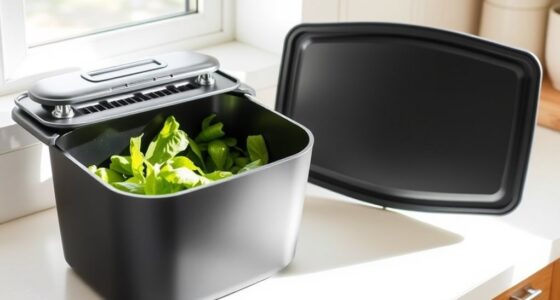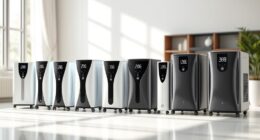Energy labels use letter grades from A to G to show how efficiently your appliances consume energy. Higher grades like A, A+, or A+++ mean better efficiency and lower energy use, which saves you money over time. Lower-rated appliances, such as G, tend to be less efficient and may cost more to operate. These labels help you compare models quickly and make smarter buying choices. If you’re curious about what these letters truly mean, there’s more to discover.
Key Takeaways
- Letter grades from A to G indicate energy efficiency, with A or A+ being most efficient and G the least.
- Higher-rated appliances (A+, A++, A+++) consume less energy and offer long-term savings despite higher initial costs.
- Labels show annual energy consumption in kWh, allowing comparison of operational costs across models.
- Standardized testing ensures ratings reflect average performance, but real-world use can affect actual energy use.
- Choosing higher-rated appliances supports environmental sustainability and reduces overall energy bills.

Have you ever wondered how to choose the most energy-efficient appliance? When you’re shopping for a new refrigerator, washing machine, or dishwasher, the energy label is your best guide. These labels aren’t just random stickers; they encode important information about how much energy an appliance consumes and how it compares to others. Understanding what the letters and symbols mean can help you make smarter choices that save you money and reduce your environmental impact.
Most energy labels feature a series of letters, usually from A to G, with A or A+ being the most efficient and G or lower letters indicating less efficient models. These classifications are based on standardized tests that measure energy consumption relative to the appliance’s size and capacity. For instance, an A+++ washing machine consumes less electricity per load than a D-rated one, meaning you’ll spend less on electricity bills over its lifespan. The labels also often include a color-coded scale, from green for the most efficient to red for the least, making it easier to interpret at a glance.
Energy labels use letter grades from A to G, with A+ or A+++ indicating high efficiency.
In addition to the letter grades, you’ll find specific figures showing annual energy consumption in kilowatt-hours (kWh). This number indicates how much energy the appliance uses in a typical year under normal conditions. Lower kWh values mean less energy use, which translates into lower utility bills. Some labels also display estimated annual operating costs, calculated based on average energy prices. This helps you compare the long-term costs of different models, taking into account not just purchase price but ongoing expenses.
It’s important to note that the letters and numbers on the label reflect average performance, but your actual energy use can vary depending on how often and how efficiently you operate the appliance. For example, a washing machine with an A+ rating might use more energy if you frequently overload it or run small loads. Conversely, using the appliance efficiently—such as washing full loads or choosing eco-friendly settings—can maximize energy savings.
Understanding what the letters really mean empowers you to choose appliances that align with your budget and values. Picking a higher-rated model might cost more upfront but can lead to significant savings over time, especially as energy prices increase. It also helps you reduce your carbon footprint by consuming less electricity generated from fossil fuels. So, next time you’re in the store, take a moment to read that energy label carefully. It’s a simple step that can make a big difference in your energy bills and environmental impact.
Frequently Asked Questions
Do Energy Labels Affect Appliance Prices?
Yes, energy labels can affect appliance prices. When you see a higher-rated label, like A+++, manufacturers often invest more in efficient technology, which can increase costs. However, these appliances save you money in the long run through lower energy bills. So, while initial prices might be higher, you’re likely to benefit from reduced operating costs over time, making energy-efficient appliances a smart investment.
Are Labels Different in Other Countries?
Yes, energy labels vary in other countries. You’ll find differences in design, letter designations, and scoring systems, depending on local regulations. For example, some countries use stars, numbers, or different color codes instead of letters. These variations can sometimes make comparing appliances tricky, so you should always check the specific labeling system in the country where you’re shopping. This helps you make informed, eco-friendly choices globally.
How Often Are Energy Label Standards Updated?
Energy label standards are typically updated every 3 to 5 years to keep pace with technological advances and environmental goals. You should check the specific regulations in your country, as updates vary by region. Staying informed helps you make better choices, guaranteeing appliances meet current efficiency criteria. Manufacturers also update product labels accordingly, so always look for the latest labeling to ensure you’re choosing the most energy-efficient options available.
Can Labels Predict Appliance Lifespan?
You might think energy labels can predict appliance lifespan, but they don’t. Surprisingly, appliances with high energy efficiency often last longer because they tend to be built with better technology and materials. However, labels mainly indicate energy consumption, not durability. As a result, while a highly rated appliance can be reliable, its lifespan depends on factors like maintenance, usage, and build quality, not just its energy efficiency rating.
Do Energy Labels Include Noise Level Info?
Yes, some energy labels include noise level information. You’ll often see this as a decibel (dB) rating on the label, helping you gauge how loud an appliance is during operation. Keep an eye out for this detail, especially if you need a quieter appliance for your home. However, not all labels display noise levels, so if it’s important to you, double-check the product specifications before buying.
Conclusion
By understanding what those energy label letters really mean, you’re revealing the secret code to a greener future. Think of it as your personal compass, guiding you through a world of choices that can brighten the planet’s horizon. Every mindful decision becomes a brushstroke in the masterpiece of sustainability. So, embrace the power of knowledge—your choices now are the seeds that will bloom into a healthier, happier Earth for generations to come.









